ABS YAMAHA YZ250F 2015 Owner's Manual
[x] Cancel search | Manufacturer: YAMAHA, Model Year: 2015, Model line: YZ250F, Model: YAMAHA YZ250F 2015Pages: 356, PDF Size: 11.39 MB
Page 182 of 356
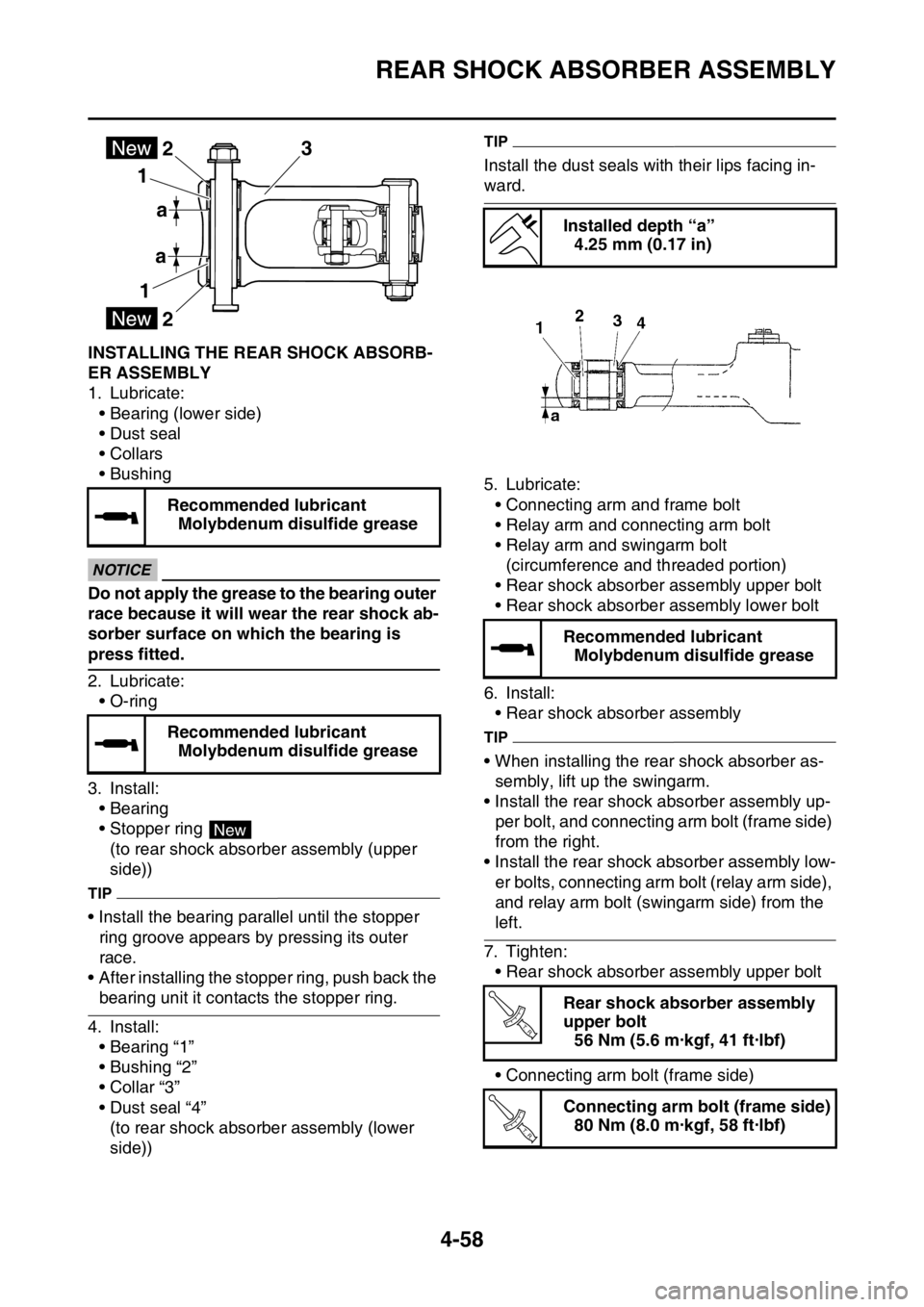
REAR SHOCK ABSORBER ASSEMBLY
4-58
EAS1SM5184INSTALLING THE REAR SHOCK ABSORB-
ER ASSEMBLY
1. Lubricate:
• Bearing (lower side)
•Dust seal
•Collars
• Bushing
ECA1DX1012
NOTICE
Do not apply the grease to the bearing outer
race because it will wear the rear shock ab-
sorber surface on which the bearing is
press fitted.
2. Lubricate:
• O-ring
3. Install:
• Bearing
• Stopper ring
(to rear shock absorber assembly (upper
side))
TIP
• Install the bearing parallel until the stopper
ring groove appears by pressing its outer
race.
• After installing the stopper ring, push back the
bearing unit it contacts the stopper ring.
4. Install:
• Bearing “1”
• Bushing “2”
• Collar “3”
• Dust seal “4”
(to rear shock absorber assembly (lower
side))
TIP
Install the dust seals with their lips facing in-
ward.
5. Lubricate:
• Connecting arm and frame bolt
• Relay arm and connecting arm bolt
• Relay arm and swingarm bolt
(circumference and threaded portion)
• Rear shock absorber assembly upper bolt
• Rear shock absorber assembly lower bolt
6. Install:
• Rear shock absorber assembly
TIP
• When installing the rear shock absorber as-
sembly, lift up the swingarm.
• Install the rear shock absorber assembly up-
per bolt, and connecting arm bolt (frame side)
from the right.
• Install the rear shock absorber assembly low-
er bolts, connecting arm bolt (relay arm side),
and relay arm bolt (swingarm side) from the
left.
7. Tighten:
• Rear shock absorber assembly upper bolt
• Connecting arm bolt (frame side) Recommended lubricant
Molybdenum disulfide grease
Recommended lubricant
Molybdenum disulfide grease
3
a 1
12
a
2
New
Installed depth “a”
4.25 mm (0.17 in)
Recommended lubricant
Molybdenum disulfide grease
Rear shock absorber assembly
upper bolt
56 Nm (5.6 m·kgf, 41 ft·lbf)
Connecting arm bolt (frame side)
80 Nm (8.0 m·kgf, 58 ft·lbf)
T R..
T R..
Page 183 of 356

REAR SHOCK ABSORBER ASSEMBLY
4-59
• Connecting arm bolt (relay arm side)
• Relay arm bolt (swingarm side)
• Rear shock absorber assembly lower boltConnecting arm bolt (relay arm
side)
80 Nm (8.0 m·kgf, 58 ft·lbf)
Relay arm bolt (swingarm side)
70 Nm (7.0 m·kgf, 51 ft·lbf)
Rear shock absorber assembly
lower bolt
53 Nm (5.3 m·kgf, 38 ft·lbf)
T R..
T R..
T R..
Page 194 of 356
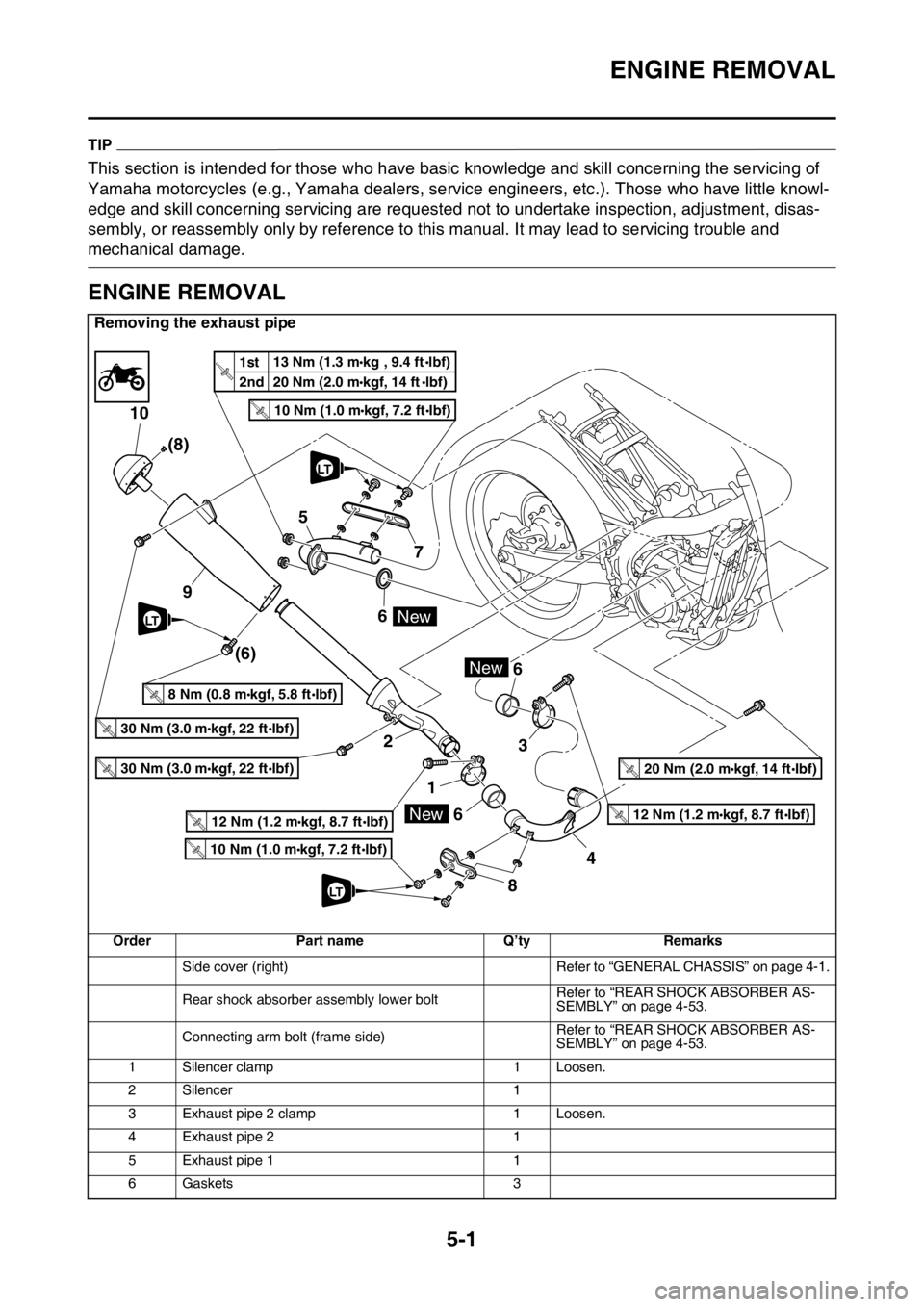
ENGINE REMOVAL
5-1
EAS1SM5196
TIP
This section is intended for those who have basic knowledge and skill concerning the servicing of
Yamaha motorcycles (e.g., Yamaha dealers, service engineers, etc.). Those who have little knowl-
edge and skill concerning servicing are requested not to undertake inspection, adjustment, disas-
sembly, or reassembly only by reference to this manual. It may lead to servicing trouble and
mechanical damage.
EAS1SM5197
ENGINE REMOVAL
Removing the exhaust pipe
Order Part name Q’ty Remarks
Side cover (right) Refer to “GENERAL CHASSIS” on page 4-1.
Rear shock absorber assembly lower boltRefer to “REAR SHOCK ABSORBER AS-
SEMBLY” on page 4-53.
Connecting arm bolt (frame side)Refer to “REAR SHOCK ABSORBER AS-
SEMBLY” on page 4-53.
1 Silencer clamp 1 Loosen.
2 Silencer 1
3 Exhaust pipe 2 clamp 1 Loosen.
4 Exhaust pipe 2 1
5 Exhaust pipe 1 1
6 Gaskets 3
10
5
9
2 6
1
66
3
84 7 (8)
(6)
30 Nm (3.0 m•kgf, 22 ftIbf)T.R.
30 Nm (3.0 mkgf, 22 ftIbf)T.R.
8 Nm (0.8 mkgf, 5.8 ftIbf)T.R.
10 Nm (1.0 mkgf, 7.2 ftIbf)T.R.
New
New
10 Nm (1.0 mkgf, 7.2 ftIbf)T.R.
12 Nm (1.2 mkgf, 8.7 ftIbf)T.R.12 Nm (1.2 mkgf, 8.7 ftIbf)T.R.
20 Nm (2.0 mkgf, 14 ftIbf)T.R.
New
1st
2nd 20 Nm (2.0 m
kgf, 14 ftlbf) 13 Nm (1.3 m
kg , 9.4 ftlbf)T.R.
LT
LT
LT
Page 199 of 356
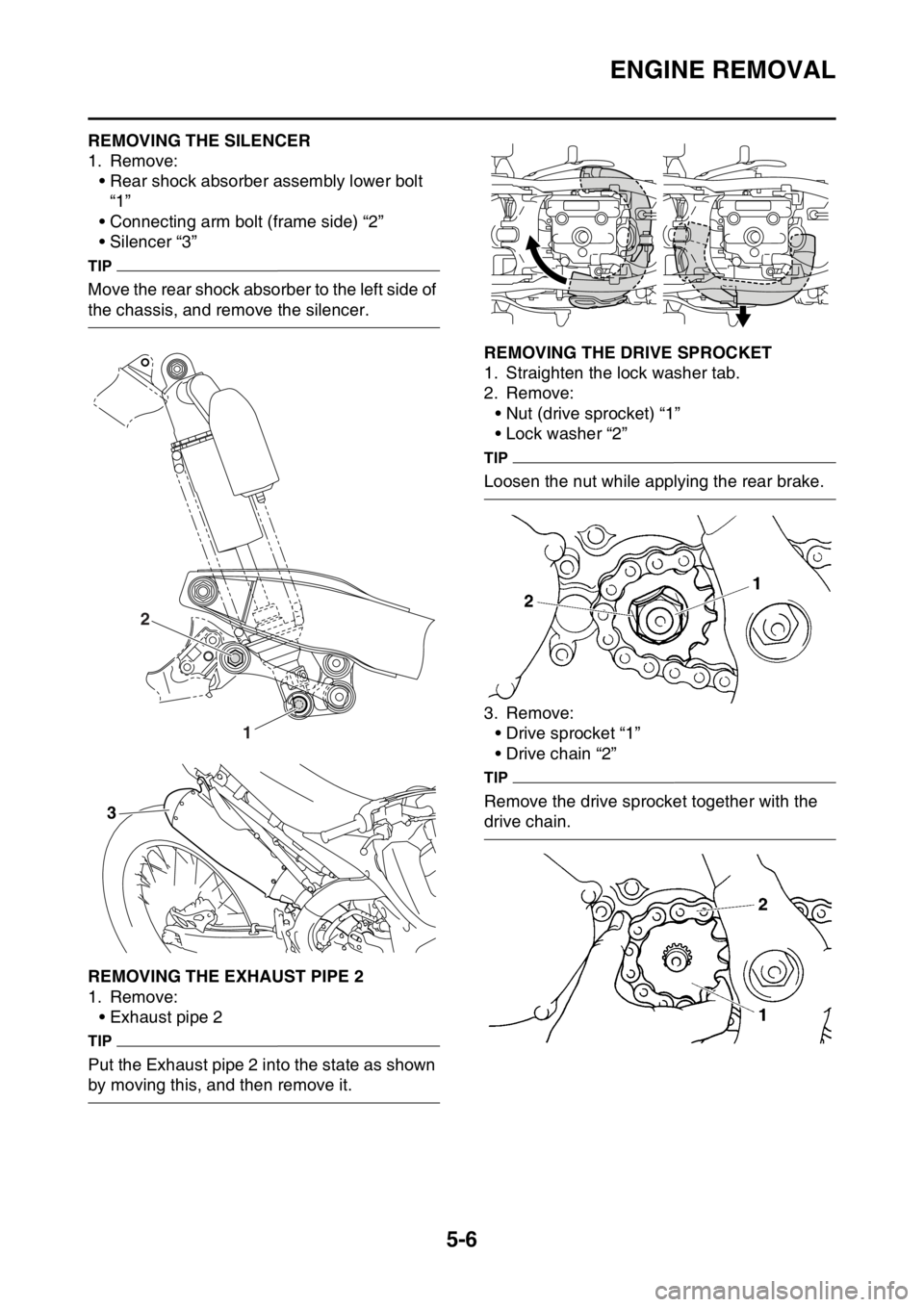
ENGINE REMOVAL
5-6
EAS1SM5198REMOVING THE SILENCER
1. Remove:
• Rear shock absorber assembly lower bolt
“1”
• Connecting arm bolt (frame side) “2”
• Silencer “3”
TIP
Move the rear shock absorber to the left side of
the chassis, and remove the silencer.
EAS1SM5199REMOVING THE EXHAUST PIPE 2
1. Remove:
• Exhaust pipe 2
TIP
Put the Exhaust pipe 2 into the state as shown
by moving this, and then remove it.
EAS1SM5200REMOVING THE DRIVE SPROCKET
1. Straighten the lock washer tab.
2. Remove:
• Nut (drive sprocket) “1”
• Lock washer “2”
TIP
Loosen the nut while applying the rear brake.
3. Remove:
• Drive sprocket “1”
• Drive chain “2”
TIP
Remove the drive sprocket together with the
drive chain.
1 2
3
Page 338 of 356

TROUBLESHOOTING
9-3
Fuel system
1. Throttle body
• Damaged or loose throttle body joint
2. Air filter
• Clogged air filter element
Chassis
1. Brake(s)
• Dragging brake
Electrical system
1. Spark plug
• Incorrect spark plug gap
• Incorrect spark plug heat range
2. Ignition system
• Faulty ECU
• Faulty coolant temperature sensor
EAS1SM5361OVERCOOLING
Cooling system
• Faulty coolant temperature sensor
EAS1SM5362POOR BRAKING PERFORMANCE
• Worn brake pad
• Worn brake disc
• Air in hydraulic brake system
• Leaking brake fluid
• Defective master cylinder kit
• Faulty brake caliper kit
• Faulty brake caliper seal
• Loose union bolt
• Damaged brake hose
• Oil or grease on the brake disc
• Oil or grease on the brake pad
• Incorrect brake fluid level
EAS1SM5363FAULTY FRONT FORK LEGS
Leaking oil
• Bent, damaged, or rusty inner tube
• Cracked or damaged outer tube
• Improperly installed oil seal
• Damaged oil seal lip
• Incorrect oil level (high)
• Loose damper rod assembly bolt
• Damaged damper rod assembly bolt copper
washer
• Cracked or damaged cap bolt O-ringMalfunction
• Bent or damaged inner tube
• Bent or damaged outer tube
• Broken fork spring
• Bent or damaged damper rod
• Incorrect oil viscosity
• Incorrect oil level
EAS1SM5364UNSTABLE HANDLING
1. Handlebar
• Bent or improperly installed handlebar
2. Steering head components
• Improperly installed upper bracket
• Improperly installed lower bracket
(improperly tightened ring nut)
• Bent steering stem
• Damaged ball bearing or bearing race
3. Front fork leg (s)
• Uneven oil levels (both front fork legs)
• Unevenly tensioned fork spring (both front
fork legs)
• Broken fork spring
• Bent or damaged inner tube
• Bent or damaged outer tube
4. Swingarm
• Worn bearing or bushing
• Bent or damaged swingarm
5. Rear shock absorber assembly (-ies)
• Faulty rear shock absorber spring
• Leaking oil or gas
6. Tire (s)
• Uneven tire pressures (front and rear)
• Incorrect tire pressure
• Uneven tire wear
7. Wheel (s)
• Incorrect wheel balance
• Broken or loose spoke
• Damaged wheel bearing
• Bent or loose wheel axle
• Excessive wheel runout
8. Frame
• Bent frame
• Damaged steering head pipe
• Improperly installed bearing race
Page 343 of 356

10
TUNING
CHASSIS........................................................................................................ 10-1
SELECTION OF THE SECONDARY REDUCTION
RATIO (SPROCKET) .............................................................................. 10-1
DRIVE AND REAR WHEEL SPROCKETS SETTING PARTS ................ 10-1
TIRE PRESSURE..................................................................................... 10-2
FRONT FORK SETTING.......................................................................... 10-2
CHANGE IN AMOUNT AND CHARACTERISTICS OF FORK OIL.......... 10-2
SETTING OF SPRING AFTER REPLACEMENT .................................... 10-3
FRONT FORK SETTING PARTS............................................................. 10-3
REAR SUSPENSION SETTING .............................................................. 10-3
CHOOSING SET LENGTH ...................................................................... 10-3
SETTING OF SPRING AFTER REPLACEMENT .................................... 10-4
REAR SHOCK ABSORBER SETTING PARTS ....................................... 10-5
SUSPENSION SETTING (FRONT FORK)............................................... 10-6
SUSPENSION SETTING (REAR SHOCK ABSORBER) ......................... 10-7
Page 346 of 356
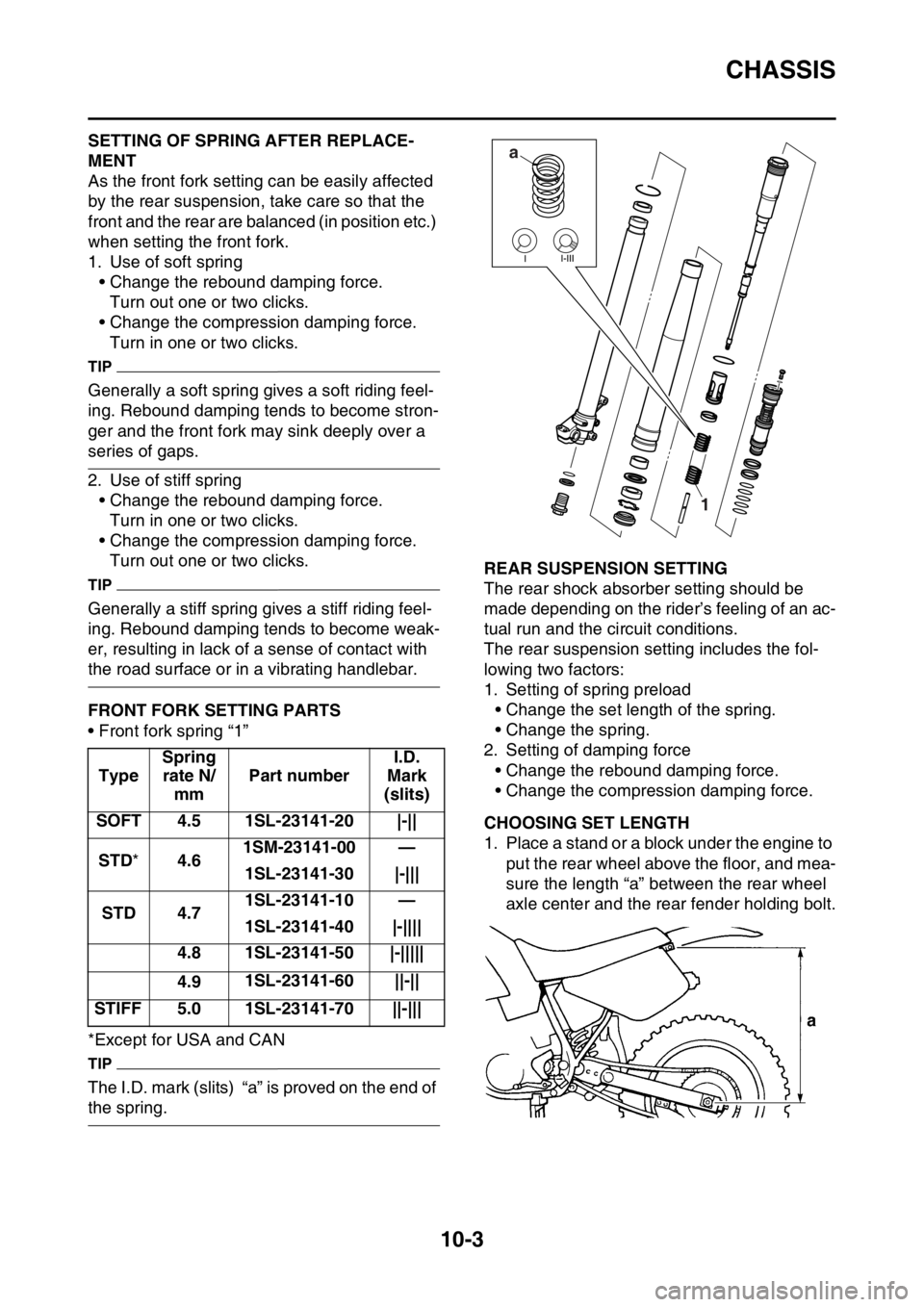
CHASSIS
10-3
EAS1SM5373SETTING OF SPRING AFTER REPLACE-
MENT
As the front fork setting can be easily affected
by the rear suspension, take care so that the
front and the rear are balanced (in position etc.)
when setting the front fork.
1. Use of soft spring
• Change the rebound damping force.
Turn out one or two clicks.
• Change the compression damping force.
Turn in one or two clicks.
TIP
Generally a soft spring gives a soft riding feel-
ing. Rebound damping tends to become stron-
ger and the front fork may sink deeply over a
series of gaps.
2. Use of stiff spring
• Change the rebound damping force.
Turn in one or two clicks.
• Change the compression damping force.
Turn out one or two clicks.
TIP
Generally a stiff spring gives a stiff riding feel-
ing. Rebound damping tends to become weak-
er, resulting in lack of a sense of contact with
the road surface or in a vibrating handlebar.
EAS1SM5374FRONT FORK SETTING PARTS
• Front fork spring “1”
*Except for USA and CAN
TIP
The I.D. mark (slits) “a” is proved on the end of
the spring.
EAS1SM5375REAR SUSPENSION SETTING
The rear shock absorber setting should be
made depending on the rider’s feeling of an ac-
tual run and the circuit conditions.
The rear suspension setting includes the fol-
lowing two factors:
1. Setting of spring preload
• Change the set length of the spring.
• Change the spring.
2. Setting of damping force
• Change the rebound damping force.
• Change the compression damping force.
EAS1SM5376CHOOSING SET LENGTH
1. Place a stand or a block under the engine to
put the rear wheel above the floor, and mea-
sure the length “a” between the rear wheel
axle center and the rear fender holding bolt. TypeSpring
rate N/
mmPart numberI.D.
Mark
(slits)
SOFT 4.5 1SL-23141-20 |-||
STD*4.61SM-23141-00 —
1SL-23141-30 |-|||
STD 4.71SL-23141-10 —
1SL-23141-40 |-||||
4.8 1SL-23141-50 |-|||||
4.91SL-23141-60 ||-||
STIFF 5.0 1SL-23141-70 ||-|||
a
1
Page 347 of 356
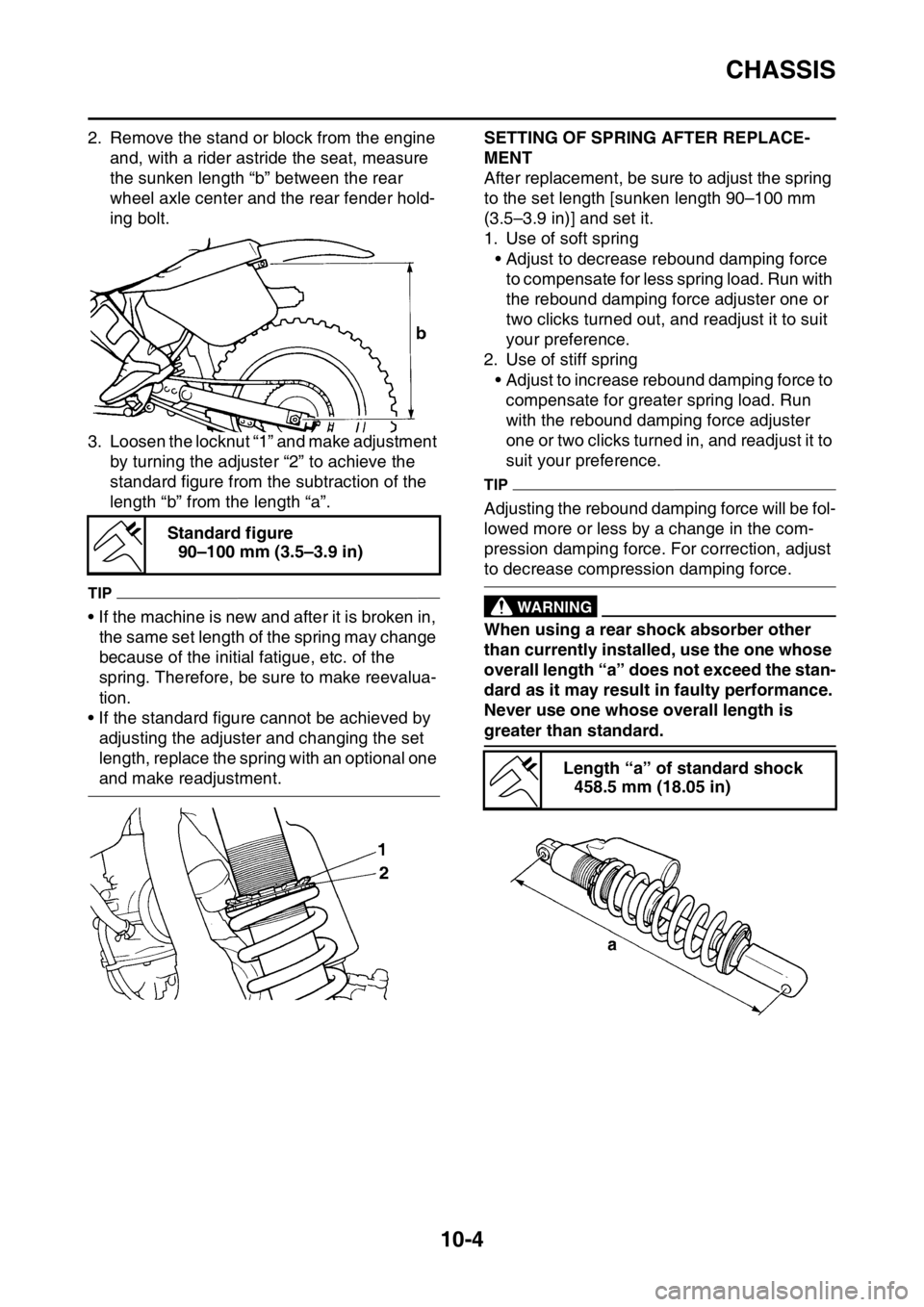
CHASSIS
10-4
2. Remove the stand or block from the engine
and, with a rider astride the seat, measure
the sunken length “b” between the rear
wheel axle center and the rear fender hold-
ing bolt.
3. Loosen the locknut “1” and make adjustment
by turning the adjuster “2” to achieve the
standard figure from the subtraction of the
length “b” from the length “a”.
TIP
• If the machine is new and after it is broken in,
the same set length of the spring may change
because of the initial fatigue, etc. of the
spring. Therefore, be sure to make reevalua-
tion.
• If the standard figure cannot be achieved by
adjusting the adjuster and changing the set
length, replace the spring with an optional one
and make readjustment.
EAS1SM5377
SETTING OF SPRING AFTER REPLACE-
MENT
After replacement, be sure to adjust the spring
to the set length [sunken length 90–100 mm
(3.5–3.9 in)] and set it.
1. Use of soft spring
• Adjust to decrease rebound damping force
to compensate for less spring load. Run with
the rebound damping force adjuster one or
two clicks turned out, and readjust it to suit
your preference.
2. Use of stiff spring
• Adjust to increase rebound damping force to
compensate for greater spring load. Run
with the rebound damping force adjuster
one or two clicks turned in, and readjust it to
suit your preference.
TIP
Adjusting the rebound damping force will be fol-
lowed more or less by a change in the com-
pression damping force. For correction, adjust
to decrease compression damping force.
EWA1DX4002
WARNING
When using a rear shock absorber other
than currently installed, use the one whose
overall length “a” does not exceed the stan-
dard as it may result in faulty performance.
Never use one whose overall length is
greater than standard. Standard figure
90–100 mm (3.5–3.9 in)
Length “a” of standard shock
458.5 mm (18.05 in)
Page 348 of 356
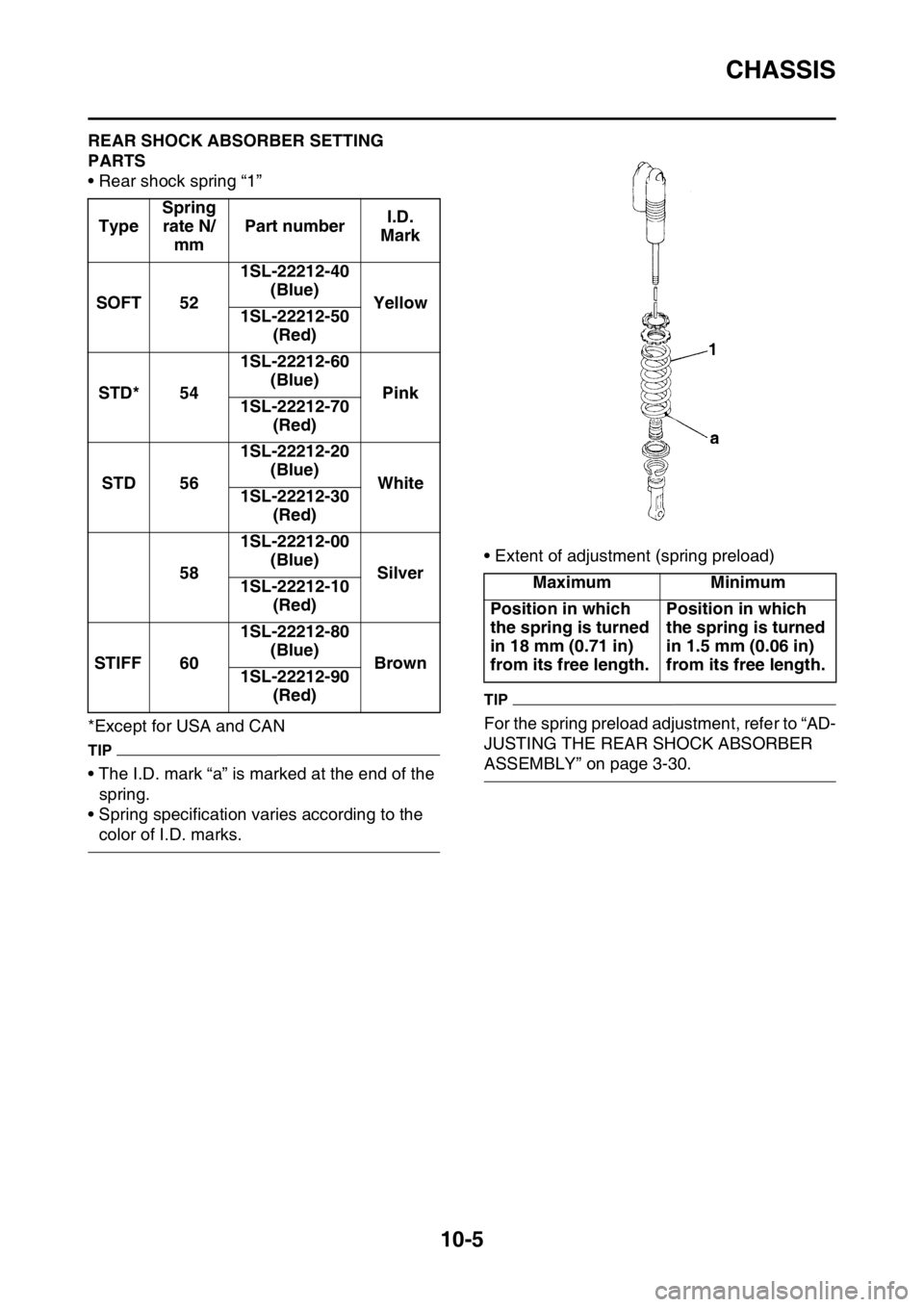
CHASSIS
10-5
EAS1SM5378REAR SHOCK ABSORBER SETTING
PARTS
• Rear shock spring “1”
*Except for USA and CAN
TIP
• The I.D. mark “a” is marked at the end of the
spring.
• Spring specification varies according to the
color of I.D. marks.• Extent of adjustment (spring preload)
TIP
For the spring preload adjustment, refer to “AD-
JUSTING THE REAR SHOCK ABSORBER
ASSEMBLY” on page 3-30. TypeSpring
rate N/
mmPart numberI.D.
Mark
SOFT 521SL-22212-40
(Blue)
Yellow
1SL-22212-50
(Red)
STD* 541SL-22212-60
(Blue)
Pink
1SL-22212-70
(Red)
STD 561SL-22212-20
(Blue)
White
1SL-22212-30
(Red)
581SL-22212-00
(Blue)
Silver
1SL-22212-10
(Red)
STIFF 601SL-22212-80
(Blue)
Brown
1SL-22212-90
(Red)
Maximum Minimum
Position in which
the spring is turned
in 18 mm (0.71 in)
from its free length.Position in which
the spring is turned
in 1.5 mm (0.06 in)
from its free length.
Page 349 of 356
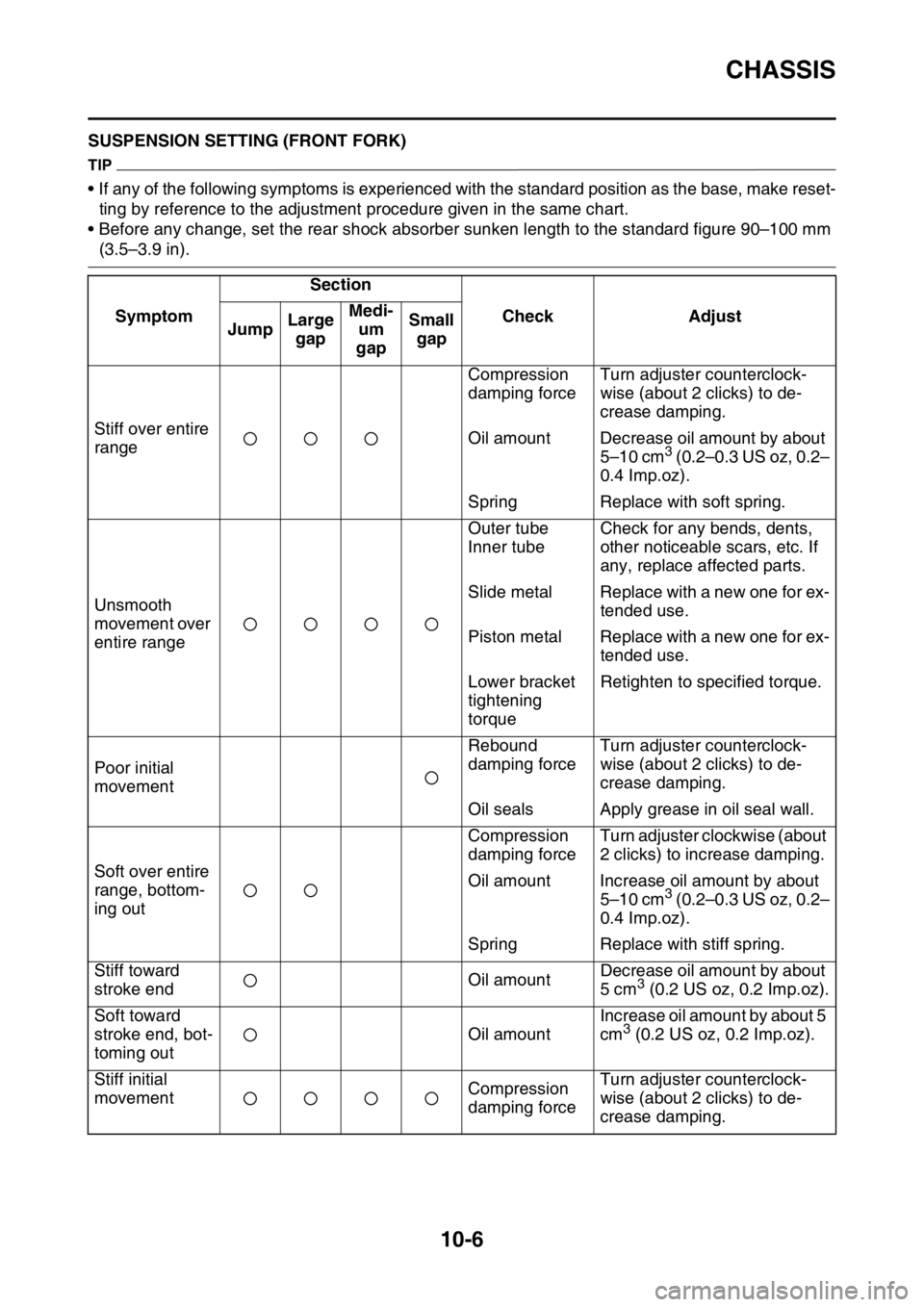
CHASSIS
10-6
EAS1SM5379SUSPENSION SETTING (FRONT FORK)
TIP
• If any of the following symptoms is experienced with the standard position as the base, make reset-
ting by reference to the adjustment procedure given in the same chart.
• Before any change, set the rear shock absorber sunken length to the standard figure 90–100 mm
(3.5–3.9 in).
SymptomSection
Check Adjust
JumpLarge
gapMedi-
um
gapSmall
gap
Stiff over entire
rangeCompression
damping forceTurn adjuster counterclock-
wise (about 2 clicks) to de-
crease damping.
Oil amount Decrease oil amount by about
5–10 cm
3 (0.2–0.3 US oz, 0.2–
0.4 Imp.oz).
Spring Replace with soft spring.
Unsmooth
movement over
entire rangeOuter tube
Inner tubeCheck for any bends, dents,
other noticeable scars, etc. If
any, replace affected parts.
Slide metal Replace with a new one for ex-
tended use.
Piston metal Replace with a new one for ex-
tended use.
Lower bracket
tightening
torqueRetighten to specified torque.
Poor initial
movementRebound
damping forceTurn adjuster counterclock-
wise (about 2 clicks) to de-
crease damping.
Oil seals Apply grease in oil seal wall.
Soft over entire
range, bottom-
ing outCompression
damping forceTurn adjuster clockwise (about
2 clicks) to increase damping.
Oil amount Increase oil amount by about
5–10 cm
3 (0.2–0.3 US oz, 0.2–
0.4 Imp.oz).
Spring Replace with stiff spring.
Stiff toward
stroke endOil amountDecrease oil amount by about
5 cm
3 (0.2 US oz, 0.2 Imp.oz).
Soft toward
stroke end, bot-
toming outOil amountIncrease oil amount by about 5
cm
3 (0.2 US oz, 0.2 Imp.oz).
Stiff initial
movementCompression
damping forceTurn adjuster counterclock-
wise (about 2 clicks) to de-
crease damping.